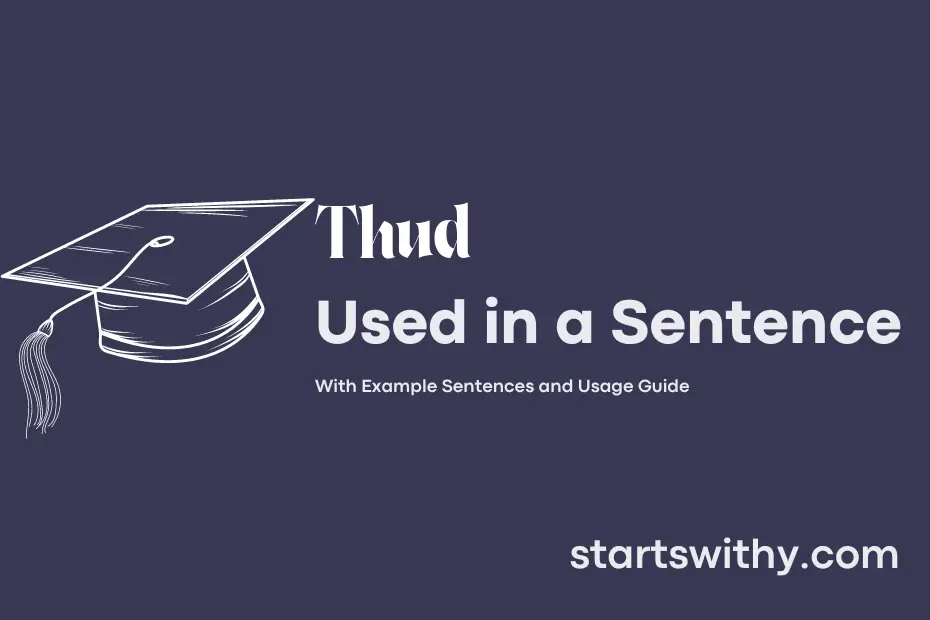Have you ever heard a loud, muffled sound like a heavy object hitting the ground? That noise is described by the word “thud.” In writing, a thud is used to represent a dull, heavy sound that indicates impact or collision.
When a writer includes the word “thud” in a sentence, it adds a sensory element that helps the reader imagine the weight and force of the object hitting a surface. This word paints a vivid picture in the mind of the reader, engaging their sense of hearing and enhancing the descriptive quality of the writing.
7 Examples Of Thud Used In a Sentence For Kids
- The coconut fell from the tree with a thud.
- The heavy book landed on the table with a thud.
- The elephant’s foot made a loud thud as it hit the ground.
- The big stone dropped into the pond with a thud.
- The door closed with a gentle thud.
- The hammer hit the nail with a loud thud.
- The basketball bounced on the ground and made a soft thud.
14 Sentences with Thud Examples
- The students heard a thud outside their dorm room late at night.
- As they practiced for their college band, they could hear the drums making a loud thud.
- The heavy textbooks made a loud thud as they fell off the table.
- With each flip of the page, a thud could be heard in the quiet library.
- The sound of the basketball hitting the court echoed with a loud thud.
- During the sports event, the discus landed with a heavy thud.
- The construction work on campus caused a constant thud that could be heard throughout the day.
- The weightlifting equipment would make a loud thud as the students dropped the weights.
- The sound of the falling branches made a distinct thud during the gardening session.
- The doors of the lecture hall closed with a heavy thud as the class began.
- The banner that fell off the wall created a sudden thud in the student council room.
- The students were startled by the unexpected thud coming from the ceiling.
- As the students packed up their instruments, the sound of cases closing created a rhythmic thud.
- The sound of the cricket ball hitting the stumps made a satisfying thud during the match.
How To Use Thud in Sentences?
To use the word Thud in a sentence, follow these simple steps:
-
Understand the meaning: Thud is a noun that describes a dull, heavy sound, often made when a heavy object falls or hits something.
-
Choose the context: Think about a scenario where a heavy object falls or is dropped to create a loud Thud sound. This could be something like a book falling off a shelf or a hammer hitting a table.
-
Construct the sentence: Create a sentence that describes the action of the heavy object falling or hitting with a dull, heavy sound.
-
Placement in the sentence: Place the word Thud in your sentence where it accurately portrays the sound in relation to the action taking place. For example, “The book fell off the shelf with a loud Thud.”
-
Check for accuracy: Make sure the context and usage of Thud in your sentence accurately represents the sound you are trying to convey.
-
Practice: To become more comfortable using Thud in sentences, practice incorporating it into various scenarios where a heavy, dull sound is made.
By following these steps, you can effectively use the word Thud in a sentence and accurately convey the sound of a heavy object falling or hitting something with a dull, heavy noise.
Conclusion
In conclusion, sentences with the word “thud” are often used to describe a heavy, dull sound that is produced when an object hits a surface with force. This onomatopoeic word effectively conveys the impact and weight of the action being described, adding a sensory dimension to the written text. Whether it is the thud of a falling tree branch, a heavy book hitting the floor, or a door closing with a solid sound, the use of “thud” in sentences brings a vividness and realism to the description of events.
By incorporating sentences with “thud” in writing, authors can engage readers’ senses and create a more immersive reading experience. The word not only describes a sound but also conveys a sense of physical presence and impact, making it a valuable tool for adding depth and detail to storytelling.



